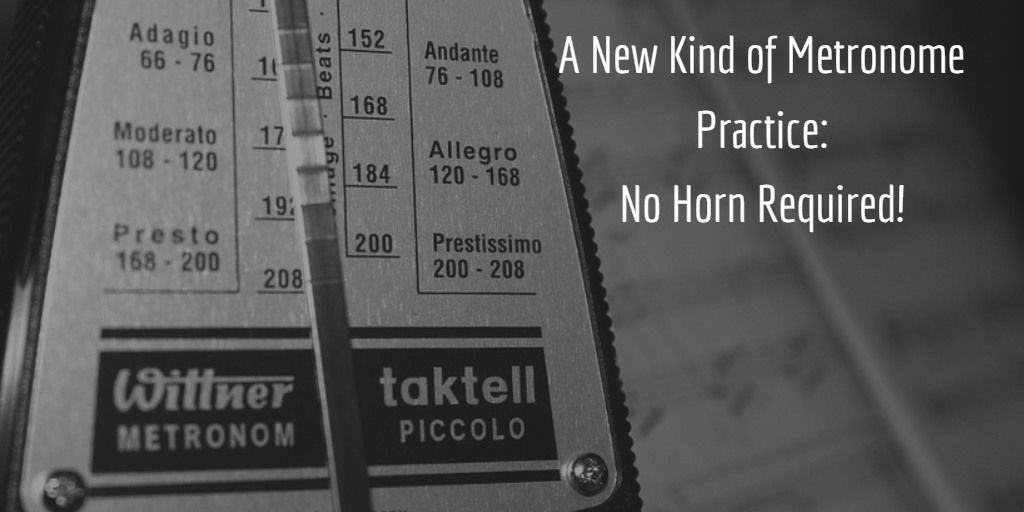“Have you practiced this with a metronome?”
Just about every music student has heard this from their teacher at least once. There’s a very good reason for this – being able to maintain a steady tempo is very important. If you can’t stay in time, you won’t play well with others!
Protip: If your teacher asks if you used a metronome, they already know that you didn’t.
The benefits of practicing specific musical passages with a metronome are obvious, but there may be advantages to practicing with a metronome at other times – even when used away from your instrument!
Metronomes + Golfers?
The BulletproofMusician recently posted an article about Swedish researchers that recruiter 26 golfers to see if their golf swing could be improved more by practicing swinging technique or by using a device called the Interactive Metronome.
The Interactive Metronome is a device that uses software and sensors to see how accurately you can tap or clap rhythms with both your hands and feet. These sensors measure your timing, and the goal is to perform the requested tasks perfectly in time with the metronome. I really like BMP’s comparison of the Interactive Metronome as a “hands + feet” version of Dance, Dance Revolution. Spoiler: I was very, very, very bad at DDR but I think I play horn okay, so take from that what you will.
You should definitely read the entire article over at BulletproofMusician.com right now! However, I don’t think it’s too much of a spoiler to mention that the half of the golfers that worked on their rhythm with metronome practice alone had a surprising result when compared to the half of the golfers that focused only on the technical aspects of their golf swing technique.
Metronome Practice Ideas Without the Horn
If you’re looking to improve your technical ability (for a challenging All-State etude, for example) here are a few ways to incorporate a metronome into your practice routine. These can be done either without playing or away from the horn entirely:
- Breathing exercises! Here are a few to try:
- In for 4, out for 4
- In for 2, out for 4
- In for 1, out for 4
- Repeat the above, but with “out for 8” instead.
- Also, tongue the airstream (no buzzing!) on the exhale – articulating eighth notes, triplets, and sixteenths and more helps with your subdividing. Especially at slower tempos!
- You can also practice “blowing” musical passages – trying to match your airspeed to “hear” the notes while you do this. No horn required.
- Finger through difficult passages at different speeds. Don’t play (and you don’t need a horn – just music), but make sure your fingers are perfectly coordinated. It’s not as easy as it sounds, especially coordination the thumb with the other three fingers and 1- or 12-23 combinations can also be tricky.
- Clap or tap multiple rhythms with your hands or feet. Don’t be afraid to mix and match hand-tapping with foot-tapping. Downbeats in one hand with foot upbeats are an easy combination. Try to do dotted-eighth-sixteenths along with constant eighths, or the classic 3+2 (triplets + eighth notes). Remember to make sure that both rhythms line up with the metronome!
- There are rhythms apps – like Rhythm Trainer for Android or Rhythm Sight Reading Trainer for iOS that can turn some of the rhythmic taps into a game. These aren’t full-body involvement like the Interactive Metronome, but the game’s variation and increased challenge can help keep it interesting!
- The BulletproofMusician article mentions Dalcroze Eurhythmics – I don’t know much about this system, but it looks like it’s a continuation and extension of some of the movement exercises mentioned above.
Final Thoughts
This kind of metronome work may not be right for everyone, but if you have technical playing problems that you’ve been unable to solve in other ways, incorporating these ideas is certainly worth a try!
Common problems on the horn (and other brass instruments) that would benefit from this horn-less metronome practice are things that require embouchure, lungs, and tongue to be precisely coordinated. Things like initial attacks, lip slurs (especially in slow music over large intervals), articulation, very short notes, etc. are all ripe for this kind of practice.
I know from first-hand experience how stressful a problem with first notes can be, and I remember well the hours spent trying to get to the root of the problem. As you probably guessed, the problem was a lack of synchronization between the face, lungs, and tongue, and it was a very frustrating problem to work on. If I could have solved (or at least improved) that problem away from the horn, that would likely have greatly improved my disposition towards the horn and practice for a while!
Questions or anything you’re curious about? Let me know in the comments below, and don’t forget to read the BulletproofMusician.com article!



Leave a Reply
You must be logged in to post a comment.